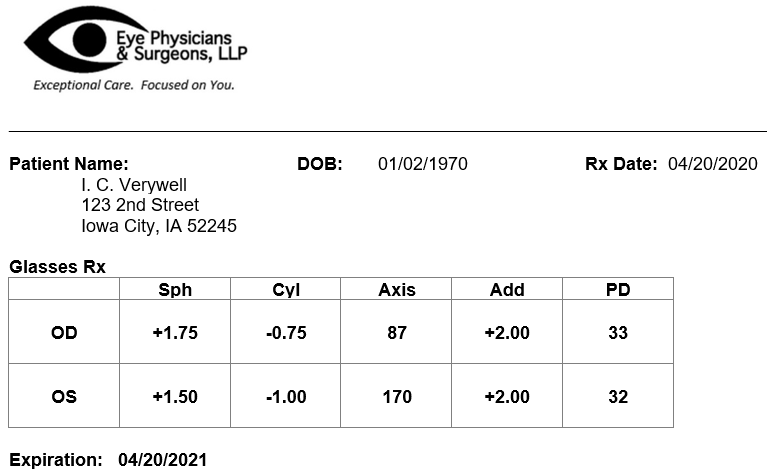Understand Your Glasses Prescription
You just finished your annual eye exam, new prescription in hand, and are considering a new pair of glasses. Whether you’ve worn glasses for years, or this is your first time, the prescription in front of you probably looks foreign. Understanding your prescription may teach you a little about your ocular health, and how your eyes have changed since your last exam.
While prescriptions vary, most will be similar to the example above. Along the left-hand side, you will see the abbreviations OD and OS. These represent:
O.D.- oculus dexter, meaning right eye.
O.S.- oculus sinister, meaning left eye.
Along the top of the grid you will likely see columns for: sphere, cylinder, axis, add power, and pupillary distance. These measurements tell the lab technician your specific lens specifications.
SPH- This is short for sphere, and tells how strong your prescription needs to be in order to correct your vision. A “+” means that you are farsighted (cannot seeing things close up). A “-” means that you’re nearsighted (cannot see far away).
CYL- This is short for cylinder, and indicates that you have astigmatism. This is a condition where the cornea or lens is irregularly shaped, and causes blurred or distorted vision. The cylinder represents to amount of astigmatism that you have.
AXIS- This describes the location for your astigmatism, and is written in degrees.
ADD- This is the amount of magnification that we will ADD to your sphere power to help you read up close. It’s used to correct presbyopia (the inability to see up close), and tells the lab that you need bifocals or progressive lenses. For single vision prescriptions, the ADD column will be blank.
PD- This is pupillary distance, and tells the lab where to place the optical center, or sweet spot of the lens, to give you the greatest clarity. This measurement is not always written on the prescription, as some opticians prefer to measure their own PD.
EXPIRATION- All prescriptions have an expiation date. Over time our ocular health will change, ultimately causing a change in our prescription. To ensure that you are using optimal vision correction, most prescriptions expire in 1 to 2 years.
At Eye Physicians and Surgeons, we take pride in writing precise eyeglass prescriptions for all of your visual needs. We look forward to seeing you for your next exam!

